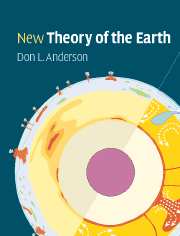Book contents
- Frontmatter
- Contents
- Preface and Philosophy
- Abbreviations and acronyms
- Part I Planetary perspective
- Chapter 1 Origin and early history
- Chapter 2 Comparative planetology
- Chapter 3 The building blocks of planets
- Part II Earth: the dynamic planet
- Part III Radial and lateral structure
- Part IV Sampling the Earth
- Part V Mineral physics
- Part VI Origin and evolution of the layers and blobs
- Part VII Energetics
- References and notes
- Appendix
- Index
Chapter 3 - The building blocks of planets
Published online by Cambridge University Press: 05 June 2012
- Frontmatter
- Contents
- Preface and Philosophy
- Abbreviations and acronyms
- Part I Planetary perspective
- Chapter 1 Origin and early history
- Chapter 2 Comparative planetology
- Chapter 3 The building blocks of planets
- Part II Earth: the dynamic planet
- Part III Radial and lateral structure
- Part IV Sampling the Earth
- Part V Mineral physics
- Part VI Origin and evolution of the layers and blobs
- Part VII Energetics
- References and notes
- Appendix
- Index
Summary
For as the sun draws into himself the parts of which he has been composed, so earth receives the stone as belonging to her, and draws it toward herself …
PlutarchThe Earth is part of the solar system and the composition of the Sun, meteorites, comets, interplanetary dust particles and other planets provide information that may be useful in deducing the overall composition of our planet, most of which is inaccessible to direct observation. Carbonaceous chondrites (CI) appear to be the most primitive and low-temperature extraterrestrial (ET) objects available to us. Even if these were the only building blocks of planets the final planet would differ in composition from them because of vaporization during accretion, and loss of low-molecular-weight material. But the ratios of refractory elements in ET materials may provide a useful constraint. Since most of the volume of a terrestrial planet is oxygen, the oxygen isotopes of candidate materials play a key role in deciding how to assemble a planet. Oxygen isotopes require that the Earth either be made of enstatite meteorites or a mixture of meteorites that bracket the isotopic composition of the Earth or enstatite meteorites. The bulk oxygen-isotopic composition of the Earth precludes more than a few percent of carbonaceous chondritic material accreting to the Earth. Mars has a different oxygen-isotopic composition from the Earth, suggesting that distinct oxygen reservoirs were available in the early solar system over relatively small annuli of heliocentric distance.
Information
- Type
- Chapter
- Information
- New Theory of the Earth , pp. 22 - 32Publisher: Cambridge University PressPrint publication year: 2007
